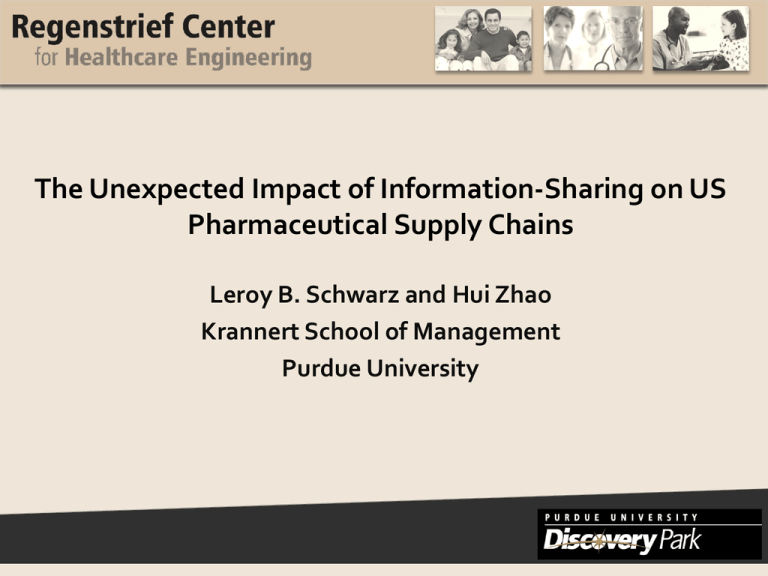Manufacturers - Purdue University
advertisement

The Unexpected Impact of Information-Sharing on US Pharmaceutical Supply Chains Leroy B. Schwarz and Hui Zhao Krannert School of Management Purdue University www.purdue.edu/rche PROJECT GOAL To examine the impact of the introduction of Fee-for-Service and Inventory-Management-Agreements (FFS/IMAs) on pharmaceutical-distributor inventories and pharmaceutical – manufacturer inventories. This change: Obligated distributors to hold much less inventory Provided “downstream” information to manufacturers www.purdue.edu/rche 2 OUTLINE Background: Pharmaceutical Supply chain The impact of FFS/IMAs on Pharmaceutical distributors The impact of FFS/IMAs on Pharmaceutical manufacturers www.purdue.edu/rche 3 4 Major Players in Pharmaceutical Supply Chains Manufacturers: Providers: Clinics, hospitals, groups of hospitals, or Integrated Delivery Networks Distributors: Also called “wholesalers”. Nearly 80% of all prescription drug volume flows through distributors. Group purchasing organizations (GPOs): They negotiate prices that its “provider-members” pay for the manufacturers’ products purchased “on contract”. www.purdue.edu/rche 4 The Pharmaceutical Supply Chain GPO Distributor Manufacturer Provider www.purdue.edu/rche Characteristics of Pharmaceutical Manufacturing International in scope In the U.S., the 10 largest pharmaceutical manufacturers account for approximately 60% of sales Brand-name manufacturers experience high profit margins Ex: Between 1995 and 2008 the top-5 manufacturers had an aggregate profit margin of 18.5% www.purdue.edu/rche Characteristics of the Pharmaceutical Distribution Highly consolidated Top three pharmaceutical distributors take over 90% market share. Very slim profit margins Virtually no profit from downstream Margin has to come from upstream; i.e., from pharmaceutical manufacturers www.purdue.edu/rche Average Annual Percentage Change in Manufacturer Prices for Widely-Used Brand-Name Prescription Drugs www.purdue.edu/rche The “investment-buying” model Secondary market Major Source of Margin: Manufacturer Price Increases Issues: Volatility, Financial Risk, Secondary Market, Lack of Transparency and no information sharing www.purdue.edu/rche Shift in Business Models The end of investment buying Catalyzed from a SEC (Securities and Exchange Commission) investigation of BMS for channel stuffing. Settlement with SEC to announce BMS’ limiting future sales based on demand Many manufacturers followed The business model of healthcare distributors was transformed during 2002/2003 “Investment buying” model (before 2002) “Fee-for-service” model (after 2003) www.purdue.edu/rche The Fee-for-Service Model Major Source of Margin: Distribution and Information Services Provided by Distributor to Manufacturers More Downstream Visibility for Manufacturer www.purdue.edu/rche The Fee-for-Service Model (Cont.) Days of on-hand inventory (DOH): Inventory targets (i.e., days of supply) with corresponding fees charged to the manufacturer. The lower the distributor’s inventory, the higher the fee it collects from the manufacturer. Service-level targets: There are usually a few levels of these targets with corresponding fees. Generally, manufacturers are charged higher fees for higher service-level compliance. Fees for Data Provided. Four major pieces of information provided to the manufacturers. www.purdue.edu/rche Data Provided by FFS/IMAs Inventory (on-hand, on-order, etc.) Sales/shipment data Demand forecast on a rolling basis. Theoretically, a distributor should charge higher fees for providing a better demand forecast. Errors in processing charge-backs www.purdue.edu/rche Under FFS… Distributors now receive margin from the manufacturer, for their service! Transparent information, which should be useful to the manufacturers in managing their own inventory! www.purdue.edu/rche 14 Data for Research Financial Information from the Top-3 distributors (AmerisourceBergen, Cardinal, and McKesson) M3 (US Census Bureau) data on US pharmaceutical and medicine manufacturing inventory dollars and shipment dollars Annual surveys conducted by the Healthcare Distributors Management Association (HDMA). Interviews of one dozen pharmaceutical supply-chain executives. www.purdue.edu/rche 15 OUR FINDINGS FFS/IMAs have had a profound effect on pharmaceutical- distributor inventory, and it appears that this occurred in two steps First, 2003-2005, in order to operate with less inventory, distributors were obliged to improve their business processes Second, 2005-2009, these improved business processes facilitated further reductions in distributor inventory www.purdue.edu/rche 16 Annual % Changes in Revenues and Inventories at Top 3 Distributors www.purdue.edu/rche Distributor Fill Rate and Reasons for Inability to Ship www.purdue.edu/rche Inventory Turnover at Big-3 Pharmaceutical Distributors www.purdue.edu/rche Inventory Changes and Savings at Big-3 Distributors www.purdue.edu/rche OUR FINDINGS (CONT.) FFS/IMAs have evidently had no effect on pharmaceutical manufacturer inventory-management practices In the short run, before manufacturers had the chance to take advantage of information provided by FFS/IMAs, theory suggests that manufacturer inventories should either increase or decrease, the net effect depending on the magnitude of some opposing influences. In the long run, once manufacturers have been able to take advantage of information provided by FFS/IMAs, theory would predict a decrease in manufacturer inventories. www.purdue.edu/rche 21 Inventory Turnover at Pharmaceutical Manufacturers (source: US Census Bureau M3) www.purdue.edu/rche Inventory Changes and Opportunity Losses at Manufacturers www.purdue.edu/rche Supply-Chain Inventory Changes and Savings www.purdue.edu/rche Are Pharmaceutical Manufacturers Using the Information for Other Purposes? Some use it on an aggregate basis to forecast quarterly sales for financial purposes Some use it to monitor inventories at specific large providers and retail accounts for sales/promotional purposes www.purdue.edu/rche Why Aren’t Manufacturers Using Information to Reduce Own Inventories? Manufacturing supply chains are long and complex Often long processing time at each step International manufacturing network Large fixed batch sizes Lack of knowledge about how to use Not on their priority list www.purdue.edu/rche IN SUMMARY • There are many reasons why manufacturers are not using this information to reduce inventories and increase inventory turnover. • But, we believe that manufacturers either don’t understand the potential of downstream information to reduce inventories, or that they don’t care www.purdue.edu/rche 27 Conclusion This work examines the introduction of information- sharing into the supply chains for pharmaceutical products in the United States. This introduction was unusual for several reasons. First, it was catalyzed from outside the industry, by SEC investigation into improper financial reporting by a single manufacturer. Second, it was initiated by pharmaceutical manufacturers in order to keep distributor inventories low. Third, although its effect on pharmaceutical distributors has been profound, evidence indicates that information-sharing has had little impact on manufacturers' own inventory-management practices. www.purdue.edu/rche 28 OPPORTUNITIES FOR SUPPLY CHAIN RESEARCHERS Healthcare-product supply chains seem to be unfamiliar to many supply chains researchers. The manufacturing supply chains are very complex lots of opportunities for learning and research Lots of opportunities for research on the distribution side, too Supply-chain design How should information provided by IMAs be used? www.purdue.edu/rche 29 CONTACT INFORMATION Leroy B. Schwarz: lschwarz@purdue.edu Hui Zhao: zhaoh@purdue.edu THANK YOU! www.purdue.edu/rche www.purdue.edu/rche







